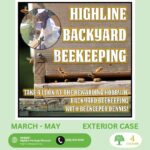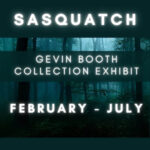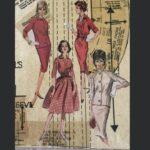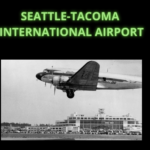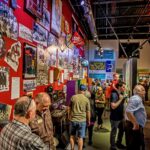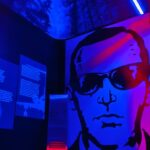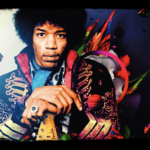May 8, 1996 • Stanley Gordon Craig “Memories”: Earliest to May 1954
Editor’s Note: A small memoir was recently donated to the Highline Historical Society. It is a compilation of the memories of Stanley Gordon Craig. Mr. Craig was born in 1928 in Edmonds, Washington, and lived through his teen years in Burien. We are reproducing some of his memories here because he recalls so much about what the area was like when he and his sister, Helen, were children.
My earliest memories: Living in a small house on a dirt road in Northern King County off 15th NW. Walking down the road to play with neighbor kids. I must have gone there a few times without permission. I remember my Mother putting some of my clothes in a paper sack and threatening to make me move down there if I didn’t stay home. I fell out of our car as we went around a corner in our neighborhood. I remember climbing up the side of the ditch. I was badly scratched and scraped but not really hurt. I didn’t lose my cookie, it was clutched in my fist. My Mother told me I said, “Wait for me youse guys.”
We moved to Maple Valley, Washington. We lived in a house on my Grandfather’s farm. I remember watching a large house burn to the ground. It was on the hill across from the cemetery. I almost fell out of another car about this time. My Mother was driving. The passenger door came open and I fell out but was able to grab the door and swing on it until the car stopped. The next place we lived was near Hobart. I was still pretty young, maybe three and a half, when Mom, Helen and I left home. I remember hiding in the woods. My Father and his friends were driving the roads looking for us. We went to a farm house and stayed there for at least a
week. These people we stayed with were not friends or acquaintances. I don’t know if this had been prearranged or spontaneous on my Mother’s part. Helen and I could only play behind the house to avoid being seen by the patrolling cars.
Eventually we made it to Seattle. My Mother had us made “Wards of the Court”. Helen and I were kept in separate sections of the juvenile detention home. I remember being well treated by the matrons there. My Mother was the only one the Court would allow to visit us. I remember being very lonesome. I don’t remember how long we stayed in JDH. It had to be a month or more. My parent’s divorce was a long, bitter battle. My Mother was a fierce fighter and eventually won custody of Helen and I. This must have been in 1932 or 33. It was after this, fall 1933, when Helen started first grade. We lived just off Rainier Ave and Genesee St. in Rainier Valley. My Aunt Lillian and Cousin Betty and the three of us lived together and at another place close to Shirley’s family, the Graff’s.
My Father came around from time to time to harass us. One time my Mother hit him with a flat iron. I remember seeing him out cold under our Christmas tree. He didn’t come around much after that.
On March 7, 1934, my Mother married Sibolt “Si” Scholtens (3 -l7-1894). We moved into a small house south of Lake City, north of Seattle. During the summer of 1934, our Dad took Helen and I for about a week. He lived in an old apartment house overlooking Elliot Bay on 1st or 2nd close to Denny Way. He took us to an Indian Potlatch somewhere on Puget Sound. That was the last contact I had with my Dad until 1949 – 50. Life in the little house by Lake City was pleasant for me. I started school there. Helen and I went by the name of “Scholtens” all through grade school.
We got a half collie/half German shepherd puppy. We named her “Mickey”. She lived until 1945. During the winter of 1935 – 36 my folks upgraded their ’20 something Whippet for a 1932 Chevrolet. We were proud of that car. During the summer of 1936, I spent two weeks with Uncle Pete and Aunt Diephe on their 40 acre farm by Duvall, Washington. They were two of my favorite people. They had two daughters, Mary and Louise. Louise still lived at home. She was 19 and beautiful. Later that
summer we drove to California. Louise came with us. It was a great trip and Louise met her future husband, Johnny Scholtens, in L.A.
In March of 1937, I was in the 3rd grade. We moved to 4905 Dawson Street in Seattle. We went to Whitworth Grade School. The house was old and creaky with two bedrooms. That first summer Dad and I raised part of the roof and made room for a place for me to sleep. It never got finished past boards over rafters for a floor.
The neighborhood was nice. We lived about one mile from Seward Park on Lake Washington. There was lots of vacant land to play on, some open and some wooded. One of my friends owned a horse. My sister and I both had lots of friends and enjoyed living there.
A bunch of us formed a baseball team and played other teams around the area. This was when I was ten, eleven and twelve. There was no organized play at that time. I joined the Cub Scouts and went to summer camp on Puget Sound somewhere. They required us to wear short pants and I didn’t like them so I dropped out. When I was 10, I got a bicycle. Most of my friends already had one so I was very happy. We took some pretty long trips on our bikes. I mowed lawns and had quite a few
regular customers. One of our favorite pastimes was playing Robin Hood in an area we called the “Big Woods”. Eventually this evolved from swords and bows to BB guns. We would choose sides and fight mini battles. There were strict rules about not shooting above the waist. Miraculously none of us lost an eye. Rubber guns were real popular. We made our own pistols and rifles. These each shot 3 – 4 rubbers each. At close range they stung pretty good. We built numerous “cabins” in
the woods. Lemonade stands were popular with Helen and I. We lived on a busy corner with lots of foot traffic.
In late 1939 or early 1940 my parents bought two acres about 2 miles south west of Burien. The area was heavily wooded in large second growth trees. We hired a bulldozer to clear a road to the property and clear an area for a house. We worked hard falling trees, cutting them into 4 ft lengths. These lengths were split with sledge and wedges and stacked to be cut later with a buzz saw.
My parents hired a contractor to build our house at 1955 SW l68th. We moved into the new house in June 1941. I was very lonesome that first summer. We did not have any near neighbors so I spent most of my free time exploring. There was lots of work to do. Clearing brush, cutting up trees that had been pushed into a huge pile. We had lots of stumps to remove. My Dad would split them by placing dynamite under them. That was always exciting. The whole area was crisscrossed with old logging roads. One day while I was exploring, a couple of horseback riders came by. One was a boy my age and the other a girl that was 3 – 4 years older. They stopped and visited with me. That was when I met Dave Elkins, (I was 12 years old) and his cousin June. It was about that time I decided to get a horse of my own.
I started 8th grade that fall 1941 at Highline Jr. High. The Junior High (8 -9) was on one end of the High School, (10,11,12).
School was 3 miles from our house and bus service was a long way away. Helen and I walked back and forth to school. We soon got to know other kids that we met also walking to school.
In September 1941, I got a morning paper route. It was tough getting up at 3:30 am. My route took me from Seahurst, around Three Tree Point and almost to Burien. The customers were far apart and up and down some crazy places overlooking Puget Sound. It didn’t take me long to figure out why no one else wanted the route. One morning I developed a bad side ache while on my route. Finally I saw a house with a light on. I called home and my mother came and took me to the hospital in Renton. I had an inflamed appendix. That day 10/13/41, they removed my appendix. I was out of school for two weeks. It was quite some time before I could return to my paper route.
The following summer,1942, I had money for my first horse. She was a short, stocky grey, that I named Smokey. That was the name of the horse in my favorite
book, “Smokey ” by Will James. Smokey was a great little horse. I never lost a race with her. Her one bad habit was “running away with you”. She was very hard to stop once she started running. I could write pages of nothing but “running away” stories. I tried everything and finally learned to reach forward and grab her bridle at the bit and pulled her head around until she couldn’t see ahead and she would stop running.
Dave Elkins and I became very good friends and did a lot of horseback riding together. Shirley Bowland (Elkins) got a horse about this time and the three of us became very good friends. Others around got horses and soon we had a large group. We rode everywhere. I got a better paper route and delivered the weeklies on Smokey. She soon learned my route so I could let her go and she would stop at each paper box and I could fold my papers between customers. In the summer of 1943 I sold Smokey and I bought a larger horse, “Smokey II”. Smokey II was a disappointment. I kept him a short time. He was very barn balky. Whenever I would try to get him to go he would rear up. An older rancher from Montana advised me on what to do when a horse continues to rear. His instructions were to pull him over backwards at the peak of the rear. The trick was to pull the horse straight backwards while stepping to the side. When I tried it, I pulled him over on top of myself. The pommel of the saddle landed on my left knee cracking my kneecap. I didn’t go to a doctor and it bothered me for years.
This rancher from Missoula, Montana invited me to come to live with him and his wife in Montana. I just didn’t want to leave home at that time. I didn’t forget the invitation. I traded Smokey II for a ’34 Chev coupe. I was 15 and when I drove my new possession home my parents were upset. I couldn’t drive it so I sold it and bought another horse. Shirley, Dave and I rode two horses to a horse trader named Bill Settles. He had a large place (acreage) where the south end of Boeing field is now. I bought a young filly (3 – 4 yrs old). She was just off the range and had never been handled. We put her between the two horses and led her home. It was 10 to 15 miles. She had never been led but learned quickly and was doing fine by the time we got her home. The three of us worked with her patiently and in no time she was a nice saddle horse. Bill Settles, the horse trader, put on an amateur rodeo on weekends during the summer. I made my first rodeo appearance there on an exhibition bareback ride. It wasn’t much of a ride but I managed to stay on until the end. The experience was very exciting and satisfying to this 15 year old.
My back was becoming a real problem. I was having trouble sleeping and sitting in class was torture. I wore a brace most of the time but it didn’t help. The decision was made to put me in the hospital and keep me in traction. I was scheduled in the hospital for January 1944. In November 1943, I decided to quit school. As I remember, Helen and Shirley decided to quit with me. Helen and I would leave for school in the morning, pick up Shirley and hang out. When the time came I entered the Swedish Hospital. I was in the hospital about a month. It was not pleasant. I had heavy weight through pulleys strapped to each foot. I had a bag of sand about 4 inches in diameter and 18 inches long under my back just below my shoulder blades. There were six of us in the ward. They all had osteomyelitis, a bone cancer. They were in their late teens and early twenties and had been hospitalized for years The guy next to me was 21 and celebrated his third year in the same bed. I got lots of visits and they rarely got any. The nurses and student nurses treated us great. The other patients were the same age as the student nurses. They let the students practice giving them shots and anything else they wanted to do. They enjoyed the nurses company. I was impressed by the nurses and the compassionate care they gave.
While I was in the hospital my folks moved from Burien to West Seattle. There was no place for my horse so I kept her at Shirley’s. When I got out of the hospital, I was required to wear a very restricting back brace at all times when I was not in bed. On top of that, I was not to ride my horse. After a couple of weeks of this nonsense, I decided to leave home. I packed a few things and hitch hiked to Burien to get my horse. Shirley tried to talk me out of leaving because she knew I wasn’t supposed to ride. After I left she called the police to get them to stop me. They didn’t find me. I rode through Renton and followed the old highway toward Snoqualmie Pass. I got as far as Newcastle the first night. I found an empty barn and spent the night there. The next day I rode to North Bend. I paid a farmer to feed my horse and walked to town and rented a room in a small hotel. It wasn’t long before there was a knock on the door. A Washington State Police officer picked me up. My folks came and got me and paid the farmer to haul my horse home. This was in February 1944. I sold my horse and saddle and bought a real working saddle. On April 13th my mother took me and my gear to the bus depot and I bought a ticket to Toppenish, Washington.
I had heard of two brothers that ranched in Toppenish. When I got to Toppenish I checked my gear and walked to the ranch. It was about two miles. The two brothers, Melvin and Carrol Lawrence, lived about a quarter mile apart on the ranch. Their ranch was in two places. The home ranch where they lived and farmed and grazing land on Toppenish Creek. In addition to this, they were half Cherokee Indian. This made them eligible to graze their cattle on the reservations open range at the base of Mt. Adams. In the spring, after the calves were born and the weather warmed, they drove their herd up to Mt. Adams. The cattle roamed free until fall when all the Indian ranchers would round them up and drive them home so they could feed them through the winter. The summers were used to put up hay, hundreds of tons of hay, 30 ton to a stack. I had arrived in April, asked for a job. They hired me for 40 dollars a month plus room and board. I was a very happy kid.
Most of our time was spent planting hay and grain. We had cows to milk, barns to clean, stock to feed, before working in the fields all day. Then we did chores until late in the evening. It was long days of hard work and I loved every minute of it. (This hard work and the hard work I did during the next four years strengthened my back and saved me from being the crippled person the doctors had predicted.)
The Lawrence brothers were two of the top rodeo performers in the area. They team roped and bull-dogged as a team and competed against each other in calf roping. They had a teenage brother that was a very good bronc rider. Just about every weekend was spent at a rodeo somewhere.
They had their own calf roping arena and they taught me how to rope calves. I learned how to rope horses in a corral, cut a cow out of a herd, castrate, brand and de-horn. It was one of the greatest times of my life, but it was a lonesome time.
During the summer my folks and another couple bought St. Helens Mfg. in Centralia, Washington. The company made Incubators, Brooders, Bread Proofing walk
– in cabinets and small boats. I returned to Burien in August, visited for a short time, bought an unbroken Mustang bay mare from Montana and moved to Centralia. I started my sophomore year over again at Centralia High School. I stayed in school about six weeks. I could stack hay all day, six days a week but I could not sit in class through one period. My back drove me crazy. My Mother took me to a doctor and he advised her to take me out of school. I found a job south of Chehalis on a ranch that raised pure bred Aberdeen Angus cattle. Iwas paid $90 a month plus room and board for myself and my mare. We worked very hard on this place, also. There was only myself and the manager.
I stayed in the house with the manager and his family. I was only allowed to be in my bedroom and the kitchen for my meals. I spent my free time in the barn with my mare. My mare, Conchita, was still pretty wild when I got theranch job. I spent so much time with her in the barn during that winter that we became bonded. I
rode her occasionally, but there was not much spare time. We worked pretty much seven days per week. It was a show ranch owned by a millionaire mill owner. It was the only place I was ever at where you wiped your feet before going into the barn. In the spring I left the ranch at Boistfort, Washington and moved back with my folks. My Dad wanted me to work for him and drive their truck. Being only 16, I needed a work permit to be a delivery boy. The permit allowed me to deliver by foot
or bicycle. I drove their 1 1/2 ton truck from Longview to Bellingham. I loved it. One day while I was grooming my mare, I noticed she was making bag. I didn’t know she was pregnant. I just thought she was fat from being in a stall all winter. Shortly after that she delivered a horse colt that I named “Spider”. Dave and Shirley came to see my colt. When I got in the stall to show him off, my mare got so nervous she kicked me. She kicked me just below my right knee cap. That was 50 years ago and the knee still bothers from time to time.
In June 1945, I went to Ellensburg and found a job on a Guest Ranch, The Lazy F. In the beginning I really enjoyed the job. My main responsibility was as a horse wrangler. In the evening the horses, about 40, were turned out on a plateau above the ranch. I got up at five each morning and brought the horses in. They were to be in the corral by 7:30 am. The range that the horses were on was quite large and very rough. The horses were not cooperative. I had to ride very hard to get them all off the plateau and in the corral. It usually took about two hours. After breakfast another hand and I groomed and saddled however many horses were needed that morning. After that I usually had fence to ride or corral to fix. There was plenty to do and I really enjoyed doing it. About every week I got a different horse to ride. It was the one that was giving the guests the most trouble. This was fine with me. They were all good horses and after a day or so we got along fine. One horse I was assigned, was an older horse that had 7 brands on him. I rode him the first morning and after a short time we got along fine. That evening when I went out to bring in
the milk cows and calves on old “Seven Brands”, as I called him, I tried something different. When we got to the cows they were spread as usual along the creek bank. I gave 7B his head and waited to see what he would do. I suspected he was an old cow pony from his brands. He nonchalantly walked by the cows as if he didn’t see them until he got past the last one. He swung round easily and took a big bite of the last cow’s rump. He then proceeded to gather them up and drove them down the canyon without any guidance from me. Rounding up all the reluctant horses in the mornings was a pleasure with 7B. He had a bad reputation for stubbornness
so I kept him as long as I could. We got along just fine.
One morning at breakfast the guides and lodge help was very animated. The boss’s wife was arriving at the ranch that day. She was a Concert Pianist and she was between tours. Once she was back, she took over. Things had been running smoothly while she was gone. Tom, the boss, always gave me and the other hand our daily instruction after breakfast. Then he would go to Ellensburg to pick up guests. After Tom’s wife was home, she would then come and change all our instructions. When Tom would get back he would get after us for not following our orders from him. One day some of the horses had gotten through the fence. Tom instructed me to find and fix the break. After Tom left and before the horses had been taken care of, Tom’s wife came and made me hoe her garden. When Tom got back that afternoon and the fence was not repaired he blew up and fired me. I got lots of sympathy from the other help and even some of the guests. We all knew Tom was mad at his wife but was unable to confront her. He took out his frustrations on the help.
I came back to Seattle. Helen’s husband, Windy, suggested I get a job on the Black Ball Ferry line. So I did. I worked on the Seattle to Bremerton ferry. I liked the work but the hours were terrible. Twelve hours a day, six days a week and every weekend and holiday. They also rotated us on a regular basis from days to nights. I liked the shipboard life but hated the hours. I decided to ship out in the Merchant Marine. I signed up and was sent to boot camp on San Clemente Island off the coast from Los Angeles. It was a regular boot camp and was run by the US Navy. We got shots, short haircuts, uniforms and a couple of noncoms to yell at us. We learned seamanship and navigation. We learned how to operate deck machinery and load and unload cargo. We learned how to fire a 20 mm machine gun and a 3 inch cannon. About half way through our twelve week training the war was over. They had no need for us anymore but we were not allowed to go home. We were transferred to a large warehouse on a dock in Wilmington, California. There was nothing to do and no where to do it. After breakfast we made our beds and were not allowed near them again until after suppertime. No one seemed to know or care what happened to us. I packed my sea bag and slipped out a side door and hitch
hiked home.
Months later I received a dishonorable discharge from the Maritime Service. This was a civilian organization so the discharge meant nothing. While I was in California, my family moved to Yakima. They sold their half of the business in Centralia and bought into a painting business in Yakima. My folks lived in a small mobile home parked next to their business. Helen and Windy had an apartment and Windy worked as a painter for the company. I moved in with Helen and Windy. It was fall and jobs were hard to find. I went to work in the sausage kitchen of one of the local slaughter house/meat packing companies. The first morning was something else. They put rubber gloves on me, rubber boots, and a rubber apron. I was led to a huge stainless steel sink filled with intestines of the freshly slaughtered cattle. My job was to straighten them out anddrape them over a moveable rack so someone else could start the cleaning process. The odor of all those fresh intestines was something to behold. I did not go in for a second day. I found another job delivering coal for Joe Klingle Fuel Company. It was very hard work but it was better than sorting intestines. I delivered and shoveled coal for about three or four months. My back would not put up with the long hours of shoveling coal. I decided to try my luck in Seattle.
Early the first morning in Seattle, I was walking down 4th Ave. to the employment office. There was quite a crowd all going to the same place. One block from the employment office, a business had a “Help Wanted” sign in the window. Everyone else walked by it but I went in. I got a job driving a delivery truck for J.M. Arnsburg Shoe Findings. I delivered supplies to shoe repair shops all over Seattle, North to Everett around the Lake and through the valley as far south as South Tacoma. I quit this job around May 1, 1946. I drove with Shirley and her Mother to Hibbing, Minnesota. Things didn’t go well there so I hitch hiked home.
During the spring of 1950 I discovered the small town of Barrett, California. It was only a wide spot in the road in hilly ranch country. It was about 40 miles southeast of San Diego, and close to the Mexican border town of Tecate, Mexico. The only business in town was a combination gas station, grocery store, cafe, and tavern with a half dozen cabins out back. To stimulate business, the proprietor put on a dance every Saturday night on an open air dance floor and a Jackpot Rodeo on Sundays. Four of us sailors rented a cabin by the month. We kept our civilian clothes there and we spent every weekend there we could. We became friends with many of the “locals” from both sides of the border that frequented Barrett.
The rodeo was the main attraction for me. I became one of the regulars in the saddle bronc division. It was real satisfying to be recognized as one of the regular performers. I got some coaching from a couple of the older riders. This helped a great deal. One Sunday, shortly after my 22nd birthday, I was fortunate enough to win first place. It was sort of a birthday gift from one of the judges. I was the last rider of the day and one of the judges quietly informed me that all I had to do was qualify. All of the riders before me had either bucked off or had been disqualified for one reason or another. Being announced as the winner before a friendly crowd
was a terrific experience. Winning had never been a factor in my participation. Riding was something I did for myself. It was a personal thing I wanted to do.
In June 1950, North Korea invaded South Korea. The Marsh was one of the first ships sent to Korea from the States. There was a great deal of preparation needed before we were prepared for war. Number one was crew. Our peace time crew of 90 swelled to 180. The new people all came from the reserves. The new people were all veterans of WWII and had higher ratings than the regular crew. This generated many problems. Our somewhat spacious quarters soon filled to over
flowing. The new, higher rated, personnel had seniority. They took over the leadership in most departments. They got the pick of the beds and lockers. It was quite an
adjustment for most of the Regular Navy crewmen. In addition to all this, all Regular Navy people got an additional year added to our enlistment time.
Our armament had to be brought to wartime strength and we had to practice using them.
All of this preparation took two months. We finally got underway to Korea early in August 1950. The Marsh was not sent to Korea, with top priority, because of her firepower. The Marsh was uniquely equipped to supply electrical power in an amount estimated to meet the needs of a city the size of Tacoma, Washington in 1950. We stopped on our way to Korea at Pearl Harbor, Midway Island and Yokosuka Japan. Japan was still in pretty bad shape from the war. Everywhere we sailed there were bombed and burned out remains of ships. Yokosuka, a major shipbuilding port with the largest dry dock in the world, was re cycling mountains of cut up warships.
We sailed for Korea almost immediately. We arrived at the seaport city of Pusan early in the day. We tied up near a WWl cargo ship that had been converted to a portable electricity generating plant. She was the only source of power for South Korea at the time. All of Korea’s hydroelectric power was generated in the North and had been cut off. When we arrived at Pusan the North controlled all of Korea except a semi-circle with a radius of 25 miles around Pusan. At night we could see and hear the fighting in the hills behind Pusan. The night watch was quadrupled. We were armed with a 45 cal. sidearm and either a Carbine or a Thompson machine gun. There was no goofing around on watch. When a large fire broke out on the docks about a mile away our skipper put us at battle stations, singled up our lines and made us ready for whatever might happen. We were all alone and very nervous. At daybreak an armed detail was sent out to gather information. The only fighting these guys had done was in a barroom somewhere. Luckily, they made no contacts so avoided shooting each other. We set up and supplied power for about a week, so the old freighter could be shut down for maintenance.
We returned to Sasebo, Japan for about a week. On the return trip to Korea, sonar detected an unidentified submarine obviously tracking us. When it failed to respond to our signal. Our Skipper decided to make a pass over it. One of our props struck something and nearly disabled us totally. We limped back to Sasebo for repairs. Our Skipper caught a lot of heat, nearly lost his command. The repair work on our ship caused us to miss the invasion a Inchon. We didn’t know about this until later, after the fact. This is what caused our Skipper to catch so much heat. We got to Inchon shortly after the area had been secured. The invasion had been a great success. The North was surprised totally and generally fled to the hills or infiltrated the locals. A small island in the Inchon harbor was fortified and tried to resist. A squadron of destroyers encircled the island and neutralized it quickly. If the fools on the island had kept their heads down and not fired on one of our destroyers we wouldn’t have known anyone was on the island. The tides at Inchon ran to thirty five feet. When the tide was out there was miles of tide flats. During tide change it was difficult for a ship to just hold its position. We had both anchors out and both engines running at near full speed just to hold our position.
After Inchon, we were sent to the small seacoast city of Masan. There we ran at nearly full speed, 24 hours a day, while tied up to the dock, to supply electricity to South Korea. The Engine Room people were working full time. The remainder of the crew had only routine duties. One day the leading petty officers in Electronics
, Radio, Radar and Sonar were temporarily transferred to the Korean Navy. The US Navy was helping the Korean government build its own navy. The four of us from the Marsh were assigned to them as advisors. Our duties at the Korean Naval Academy were to assist the Koreans with the translation of our technical manuals. The translators were all highly educated men, fluent in English. However, they had great difficulty with the technical and Naval terminology. They also had difficulty
staying on task because of their intense curiosity about all things American. All in all, the work was not very exciting but it was challenging and interesting. The Academy was located in what had been a large Japanese naval base. The facilities were in excellent shape. Our little group was housed in a beautiful Japanese house. We had a housekeeper, a houseboy and a cook. Our meals were served family style, we slept in regular beds, our room were cleaned and our laundry done. This was quite a change from shipboard living. However there was no entertainment.
We were an island in a sea of hostility. We were not allowed off the base because the surrounding hills were controlled by the North Koreans. A Marine patrol from
the base had been badly shot up shortly before we arrived. The base was reasonably secure. We controlled the sea and the sky but they controlled the hills. When the translations were completed we returned to our ship by truck. I don’t remember much about the return trip. We were part of a small convoy. As I remember there were South Korean troops (R.O.K.) and US Marines in the convoy. There were still many North Koreans in the hills. They had been cut off from the North by the UN forces. They sustained themselves by raiding local villages and ambushing small groups. Our group was large enough and well armed so we had no problems. We were a nervous and excited group of sailors. The roads were bad and the terrain was very rugged. We were all happy to get back to the ship. Shortly after we got back aboard ship we were reassigned back to San Diego. Our first stop was Japan. We took on fuel, supplies and a new Skipper. Our new Skipper was a pleasant change from our old one in that he was even tempered, confident and had a sense of humor. The rest of the ships officers became more relaxed and as a result shipboard life was more pleasant.The fact that we were returning home also helped.
About half way home, I picked up Radio Station KING Seattle. That was a real thrill. We returned to San Diego in May or June 1951. One of the first things I did was buy a1946 two-door Ford. I had been without wheels for over three years. On my first free weekend I went back to Barrett. It was like going home. Very little had changed while I was gone. My old buddies, the Philippino cook and the wino dishwasher, were still there. I was the only one of our original group that hadn’t been discharged or transferred. It wasn’t long before I had another shipmate coming with me. My new partner, Tom, inadvertently caused my first and only barroom fight. It almost got me thrown in jail. Tom wanted to take two of the local young ladies home. I tried explaining to him that these two were trouble, but he insisted. I loaned him my car and they left. As it turned out later, the girls were trying to avoid three drunk guys at the dance. After Tom and the girls had gone, these three guys decided to attack me. One hit me in the face and stunned me. I grabbed him in a bear hug and threw him to the floor. Two deputies grabbed me. They proceeded to cuff me and were going to haul me away. Fortunately, numerous people came to my aid and I was released. My three adversaries split. Later I learned that my old buddies, the cook and the dishwasher, had jumped on the backs of the other two as soon as the fight started. A couple of weekends later, three young Marines came and apologized for the ruckus. They had gotten angry because my friend had taken the two girls home and took their frustration out on me.
I rode some in ’51, but things had changed and so had 1. After awhile I stopped going there completely. We were kept quite busy for the remainder of 1951. In early Feb ’52, I was given the option of using up my accumulated leave time or taking an early discharge. That was an easy decision. On 2/9/52 I headed home. When I left the Navy I had a plan. I wanted to live in Eastern Washington. Good jobs were not plentiful and after some thought, the Telephone Company seemed the logical answer. Immediately upon arrival in Yakima, I went to the Telephone Company and made an application. They were interested in me and after some negotiation they agreed to credit me for my four years of electronics training and experience. Everything was a done deal except final approval from Seattle. Three weeks went by and no word from Seattle. My funds were running out and I needed a job. One day I spotted an ad for an electronic tech to work at the Navy Torpedo Station at Keyport,
Washington. I drove to Keyport and was hired by the Navy. Once I passed the security clearance for Top Secret, I was assigned to a small team, two engineers and six techs working to perfect a new type anti-submarine torpedo. We spent about two days each week on a restricted area of Hood Canal called Dabob Bay, testing our torpedo. It was interesting work and I learned a lot about electronic tests and instrumentation.
It was during this time that I was finalizing the design on an idea I had for a cigarette and cigar disposal unit for motor vehicles. One day at break one of the engineers mentioned to the other that “one of these days I’m going to design an automatic ashtray emptier”. I decided immediately to make a move on my own design. I went to a Patent Attorney in Seattle and applied for a patent. Once the US Patent Office had accepted my application for consideration and issued me a Patent Pending Certificate, I quit my job. On the advice of my attorney I took a train to Detroit, Michigan to sell my device. No one was interested and I came home disappointed. On the way back, I stopped at Yakima to see my folks. A neighbor boy was in the process of enrolling at Yakima Junior College. After talking to him about it, I decided to do the same. I enrolled for the fall term 1952. I passed all their entrance exams and was signed up for three five hour classes. English, Physics and Geometry. I found a job at the local Safeway Store. English classes were a struggle. Physics and Geometry, at the JC level, were not. One day, shortly after mid-term exams, I was summoned to the Registrar’s office. She was very indignant and wanted to know why I was attempting to go to college having not gone to high school. With the recommendations of my instructors and a 3.33 GPA, I was reluctantly allowed to continue.
I did not like living with my folks so after fall quarter I moved to Seattle with a plan to work at Boeing and attend the University of Washington. Eventually I realized these goals. After a short stint with Safeway in Seattle, and their rejection of my plan to automate their stores, I found a job as a TV Technician. The first 3-4 months I spent climbing on the roofs of Seattle putting up television antennas. Television was a new industry and each TV set needed a strong, and depending on the area, a very tall antenna. The reason for all the antenna activity was a new station on the air. In addition to channels 4 and 5 in Seattle, there was now channel 11 in Tacoma.
After working in the shop for a short while I was offered my own shop at their new store in Renton, Washington. The new store did poorly and I went to work on the swing shift at Boeing and ran the shop during the day and on weekends. One half of my plan was realized.
About one-third of my calls at the new store were for appliance repair. After a shaky start I soon became somewhat proficient at repairing washers and dryers. After about 10 months they announced the store was closing in June 1954. I started phasing out my end of the operation. At this time I decided to take some dancing lessons. I could dance but there were dances I wanted to learn. I found a couple that gave dancing lessons at their home. Their names were Joe and Eleanor. They had two little girls and Joe worked for Darigold Farms. I enjoyed the lessons and we became friends. My cousin Pat and I fell some trees for them. The only problem was that I had no one to practice with. My social life, since getting out of the Navy, had been zero. All I had done is work and go to school for over two years. With my shop virtually closed, I decided to take some time off during Memorial Day Weekend 1954. There was a special dance that weekend featuring Tommy and Jimmy Dorsey
and their newly united bands at the Trianon Ball Room. I decided to go.
There was a huge crowd at the dance when I arrived. Most of the people were standing on the dance floor in front of the band. I noticed an attractive young lady sitting with a couple in a booth. I decided to ask her for a dance. She accepted my invitation. We danced very well together, so we spent the rest of the dance together. The couple she was with was her oldest brother “Bud” and her roommate Sally. Bud was a TV technician and ex Navy, so we had a common bond. After the dance, the four of us went out to eat. I had found a friend, Ralph “Bud”Farrell and a dancing partner, Norma Ann Farrell.


